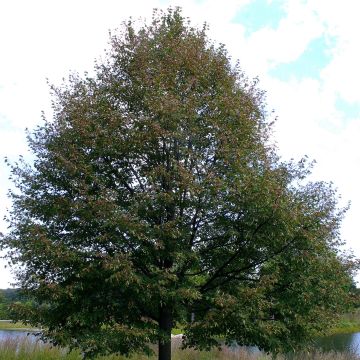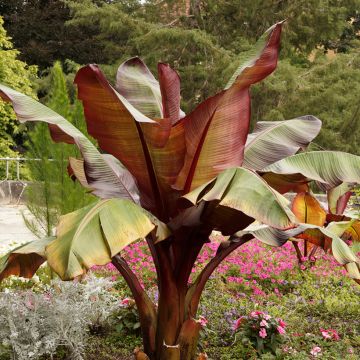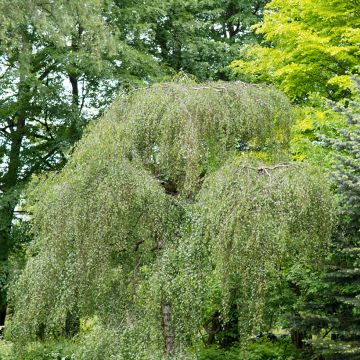

Tilia cordata Winter Orange - Small-leaved Lime
Tilia cordata Winter Orange - Small-leaved Lime
Tilia cordata 'Winter Orange'
Small-leaved Lime, Littleleaf Linden
Special offer!
Receive a €20 voucher for any order over €90 (excluding delivery costs, credit notes, and plastic-free options)!
1- Add your favorite plants to your cart.
2- Once you have reached €90, confirm your order (you can even choose the delivery date!).
3- As soon as your order is shipped, you will receive an email containing your voucher code, valid for 3 months (90 days).
Your voucher is unique and can only be used once, for any order with a minimum value of €20, excluding delivery costs.
Can be combined with other current offers, non-divisible and non-refundable.
Home or relay delivery (depending on size and destination)
Schedule delivery date,
and select date in basket
This plant carries a 24 months recovery warranty
More information
We guarantee the quality of our plants for a full growing cycle, and will replace at our expense any plant that fails to recover under normal climatic and planting conditions.
Would this plant suit my garden?
Set up your Plantfit profile →
Description
Tilia cordata 'Winter Orange' is a moderate-sized small-leaved Lime tree that stands out for its orange branches, which are particularly visible in winter. Other advantages of this deciduous tree include beautiful butter-yellow foliage in autumn, interesting cracked bark, and fragrant, nectar-producing flowers in early summer. This lime tree is also hardy and not very demanding in terms of soil.
Tilia cordata belongs to the Tiliaceae family and is native to European forests. It is a large deciduous species with a wide crown, capable of reaching heights of over 30 metres. It can be found in hill and mountain zones, growing up to 1500 metres above sea level, usually on moist, deep, fertile, and neutral to calcareous soil. It has an excellent longevity.
The 'Winter Orange' cultivar was discovered in 1977 in a forest and introduced to the market in 1988 by J. Lombarts in Zundert, the Netherlands. It has a rather slow growth rate and reaches a maximum height of 11 metres with a spread of 6 metres. Its crown is ovoid, branched, and dense. The trunk is often quite short. The bark, when mature, is dark brown and channelled, while the smooth young branches are orange. Its entire, alternate leaves are 7 to 12 cm long, rounded, heart-shaped at the base, and finely toothed at the edges. The upper surface of the leaf is matte green, while the lower surface is glaucous green with reddish-brown hairs. The leaves turn butter-yellow in autumn and fall quite early in the season. Flowering occurs in early summer, in June. Numerous small white-yellowish flowers are grouped in pendulous corymbs of 15 to 20 attached to the branches by long petioles. They are remarkably fragrant and a delight for bees. They are followed by small, slightly fuzzy, grey round fruits attached to a wing called a samara.
The 'Winter Orange' Lime tree can be planted as a standalone specimen and is an easy tree to cultivate in many regions, with a manageable size. It can be enhanced when surrounded by evergreen shrubs like Taxus media 'Densiformis' or other dwarf conifers. For a more rustic look, it can be paired with Persian Ironwood or Katsura tree, which offer interesting autumn colours. Plant it alongside maples (Acer campestre 'Carnival', A. griseum...), Pseudocydonia sinensis, and Winged Spindle tree (Euonymus alatus) to create a vibrant woodland area from September to November. Its flowers are an important source of nectar, which is valuable for beekeepers.
Report an error about the product description
Plant habit
Flowering
Foliage
Botanical data
Tilia
cordata
'Winter Orange'
Malvaceae
Small-leaved Lime, Littleleaf Linden
Cultivar or hybrid
Other Tilia - Linden
View all →Planting and care
The 'Winter Orange' Small-leaved Lime is preferably planted in autumn, or at the latest in early spring. It is hardy and not very demanding in terms of soil. It tolerates wind and sea spray quite well. It requires a sunny exposure, or at the most, partial shade. It fears soils that are too dry and shallow, but it tolerates acidic or, on the contrary, limestone soils, as long as they are not too poor. A deep, fertile, and moist soil, well loosened, will ensure optimal growth. In the first few years, undertake formative pruning by removing the lower branches to allow for easy movement under the tree.
Planting period
Intended location
Care
This item has not been reviewed yet - be the first to leave a review about it.
Similar products
Haven't found what you were looking for?
Hardiness is the lowest winter temperature a plant can endure without suffering serious damage or even dying. However, hardiness is affected by location (a sheltered area, such as a patio), protection (winter cover) and soil type (hardiness is improved by well-drained soil).

Photo Sharing Terms & Conditions
In order to encourage gardeners to interact and share their experiences, Promesse de fleurs offers various media enabling content to be uploaded onto its Site - in particular via the ‘Photo sharing’ module.
The User agrees to refrain from:
- Posting any content that is illegal, prejudicial, insulting, racist, inciteful to hatred, revisionist, contrary to public decency, that infringes on privacy or on the privacy rights of third parties, in particular the publicity rights of persons and goods, intellectual property rights, or the right to privacy.
- Submitting content on behalf of a third party;
- Impersonate the identity of a third party and/or publish any personal information about a third party;
In general, the User undertakes to refrain from any unethical behaviour.
All Content (in particular text, comments, files, images, photos, videos, creative works, etc.), which may be subject to property or intellectual property rights, image or other private rights, shall remain the property of the User, subject to the limited rights granted by the terms of the licence granted by Promesse de fleurs as stated below. Users are at liberty to publish or not to publish such Content on the Site, notably via the ‘Photo Sharing’ facility, and accept that this Content shall be made public and freely accessible, notably on the Internet.
Users further acknowledge, undertake to have ,and guarantee that they hold all necessary rights and permissions to publish such material on the Site, in particular with regard to the legislation in force pertaining to any privacy, property, intellectual property, image, or contractual rights, or rights of any other nature. By publishing such Content on the Site, Users acknowledge accepting full liability as publishers of the Content within the meaning of the law, and grant Promesse de fleurs, free of charge, an inclusive, worldwide licence for the said Content for the entire duration of its publication, including all reproduction, representation, up/downloading, displaying, performing, transmission, and storage rights.
Users also grant permission for their name to be linked to the Content and accept that this link may not always be made available.
By engaging in posting material, Users consent to their Content becoming automatically accessible on the Internet, in particular on other sites and/or blogs and/or web pages of the Promesse de fleurs site, including in particular social pages and the Promesse de fleurs catalogue.
Users may secure the removal of entrusted content free of charge by issuing a simple request via our contact form.
The flowering period indicated on our website applies to countries and regions located in USDA zone 8 (France, the United Kingdom, Ireland, the Netherlands, etc.)
It will vary according to where you live:
- In zones 9 to 10 (Italy, Spain, Greece, etc.), flowering will occur about 2 to 4 weeks earlier.
- In zones 6 to 7 (Germany, Poland, Slovenia, and lower mountainous regions), flowering will be delayed by 2 to 3 weeks.
- In zone 5 (Central Europe, Scandinavia), blooming will be delayed by 3 to 5 weeks.
In temperate climates, pruning of spring-flowering shrubs (forsythia, spireas, etc.) should be done just after flowering.
Pruning of summer-flowering shrubs (Indian Lilac, Perovskia, etc.) can be done in winter or spring.
In cold regions as well as with frost-sensitive plants, avoid pruning too early when severe frosts may still occur.
The planting period indicated on our website applies to countries and regions located in USDA zone 8 (France, United Kingdom, Ireland, Netherlands).
It will vary according to where you live:
- In Mediterranean zones (Marseille, Madrid, Milan, etc.), autumn and winter are the best planting periods.
- In continental zones (Strasbourg, Munich, Vienna, etc.), delay planting by 2 to 3 weeks in spring and bring it forward by 2 to 4 weeks in autumn.
- In mountainous regions (the Alps, Pyrenees, Carpathians, etc.), it is best to plant in late spring (May-June) or late summer (August-September).
The harvesting period indicated on our website applies to countries and regions in USDA zone 8 (France, England, Ireland, the Netherlands).
In colder areas (Scandinavia, Poland, Austria...) fruit and vegetable harvests are likely to be delayed by 3-4 weeks.
In warmer areas (Italy, Spain, Greece, etc.), harvesting will probably take place earlier, depending on weather conditions.
The sowing periods indicated on our website apply to countries and regions within USDA Zone 8 (France, UK, Ireland, Netherlands).
In colder areas (Scandinavia, Poland, Austria...), delay any outdoor sowing by 3-4 weeks, or sow under glass.
In warmer climes (Italy, Spain, Greece, etc.), bring outdoor sowing forward by a few weeks.













































